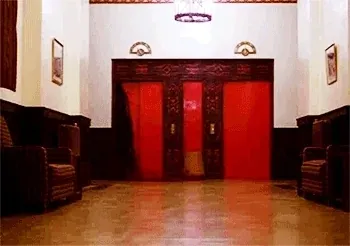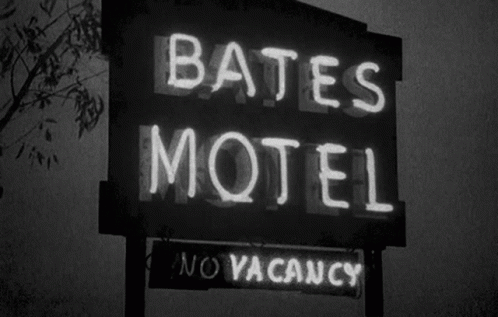On Setting in Horror
Fear's arena matters.

Physiological fear. Fear that bursts through your muscle fibers and floods your chest cavity. The fear you can taste in moments of real physical danger.
I’ve only had that a handful of times.
Thanks for reading Lane Talbot! Subscribe for free to receive new posts and support my work.
One moment of deep personal fear I still think about occurred on a mountain roadside in northern Arizona in the middle of the night. I was 19 and driving up from Phoenix with my girlfriend at the time. A cloudburst reduced my visibility to zero so I pulled over to wait it out while she slept in the passenger seat.
We were parked on a mountainside in the dead of night in the middle of nowhere during a ferocious rainstorm. But that wasn’t scary. What was scary, was the mystery pickup truck rolling down the mountain toward us, inexplicably slowing, crossing the median and the empty lane to park directly before us and immediately activate its high beams into my car. We just sat there.
No explanation. No clear intent.
It could have been someone trying to help, I thought. But there are other, smarter, less ominous ways to signal your intention to help. This felt like the opposite of that.
Whoever it was, they just sat there, flooding my ridiculous little car with burning white light. I turned on my lights too; I’m sure that had no effect. None of this woke my girlfriend. I experienced dread independently. I figured the odds were 50/50 the situation was about to turn irreversibly bad.
What’s the most important element of horror?
It’s probably character, right? It’s always character. What’s American Psycho without Patrick Bateman?
Or maybe it’s conflict. What’s Deliverance without that little confrontation by the river?
I don’t think setting is the most critical component of horror, but I do think it’s way up there.
The Bates Motel is a manifestation of Norman’s violent mind. In Jaws, the ocean itself—the shark’s domain—slowly and inexorably drags The Orca to its doom. The hotel room in Old Boy is nothing less than a perfect diorama of hell.

Horror fills space. The more finely crafted the space, the more beautiful the horror.
Stephen King’s The Gunslinger has been around for a while. It’s not his best work and in the introduction to the edition I read most recently he’s direct about it: “The Gunslinger had been written by a very young man, and had all the problems of a very young man’s book.”

I’ve read it twice and what strikes me isn’t its ramshackle structure, delicious pulp-fiction violence, or even that reliably soul-comforting Stephen King voice laying down the scares. What stands out amongst of all that, is the oppressive dead heat of the ghoulish and malign desert. The bone-brittle desiccation of this wilder, mentally ill west. The vivid and bloody stage King presents here is just as beautiful as—if not more so than—the penny dreadful enacted upon it.
Here’s the second paragraph of the novel: “The desert was the apotheosis of all deserts, huge, standing to the sky for what looked like eternity in all directions. It was white and blinding and waterless and without feature save for the faint, cloudy haze of the mountains which sketched themselves on the horizon and the devil-grass which brought sweet dreams, nightmares, death. An occasional tombstone sign pointed the way, for once the drifted track that cut its way through the thick crust of alkali had been a highway. Coaches and buckas had followed it. The world had moved on since then. The world had emptied.”
As you may know, The Gunslinger is our introduction to Roland Deschain, the final knight errant of Mid-World. In this first volume of King’s magnum opus, Roland pursues the Man in Black across the desert. It’s a simple quest made compelling by madness, time-loops, more madness, and eventually monsters.
Deserts are places of death. The Latin dēserere means “to abandon or forsake.” The desert of The Gunslinger is the image of abandonment. The world had moved on, indeed.
Where are we? There are some familiarities between this place and ours. We get signage we might recognize, lyrics to pop songs we know, etc. But this isn’t just another off-the-shelf post-apocalyptic reflection of our civilization; The Dark Tower series is a lunatic spaghetti western splashed with high-fantasy and comic book tropes like wizardry, knighthood and horror.
This is King’s Lord of the Rings. This is Mid-World, baby.
That night on the ridge, I was pinned between the mountain, its edge, and the enormous mystery truck—and I was blinded by torrential rainfall and a glacier of livid white light.
I could not back up and I could not advance. So I sat there, listening to the storm and the steady boom of the engine block rumbling a few feet directly in front of my face.
At this time in my life, I didn’t carry much with me regularly save a plug-in Discman and a pack of Parliament Lights. So I didn’t have anything really helpful with me except for a wooden baseball bat and a cheap knock-off katana (different story).
This couldn’t last all night. Eventually I made some decision. I opened my door and held both the bat and katana aloft in the rain.
My intention—if it could be said that my contracting, panic-soaked, 19-year-old brain was capable of intention—was to signal that, whatever this was, I was ready to get forceful if I had to. I stepped out of the car.
The edition of The Gunslinger I have offers a meditation on the source material from the author: “before [The Good, The Bad and The Ugly] was even half over, I realized that what I wanted to write was a novel that contained Tolkien’s sense of quest and magic but set against Leone’s almost absurdly majestic Western backdrop… What I wanted even more than the setting was that feeling of epic, apocalyptic size. The fact that Leone knew jack shit about American geography (according to one of the characters, Chicago is somewhere in the vicinity of Phoenix, Arizona) added to the film’s sense of magnificent dislocation.”
The Good the Bad and the Ugly. Well, that certainly figures.
If you’ve seen the Dollars trilogy—or even if you haven’t, you’ve probably been exposed to a few of its most famous frames.

Roger Ebert wrote: “John Ford made Monument Valley the home turf of his Western characters, and he made great films there, but there is something new and strange about Leone's menacing Spanish vistas. We haven't seen these deserts before. John Wayne has never been here. Leone's stories are a heightened dream in which everything is bigger, starker, more brutal, more dramatic, than life.”
Bigger, starker, more brutal, more dramatic. That’s Mid-World here. The saturation of color, noise, and danger is all dialed past the limit. Everything is maximum. “The desert was the apotheosis of all deserts.” Can’t get much more desert than that.
Our protagonist Roland, a man of action, is certain in his mission to pursue and confront the Man in Black. Roland is of Mid-World and so operates here with fluency.
The danger then, comes in the introduction of Jake. A boy explicitly not from Mid-World, but inexplicably transported into its desert.
When Roland’s previously simple mission is complicated by the presence of Jake—a small boy—not born of this bigger, starker, more brutal desert, we get stakes. Jake doesn’t belong here. This desert will swallow him. Mid-World itself impends upon him—to his, and our, horror.
What. The. Fuck. Would I have done if the driver stepped out of his truck with a gun? What if he had just run me over? What did I think I was going to do with my little league baseball bat or my stupid katana? What if my girlfriend—just as young and incompetent as me—had woken up at that exact moment?
I was a 19 year-old kid from the suburbs of Chicago. I had been in Arizona one year. And in that year, I had concluded that half of the people I encountered there carried guns, the other half used or sold crystal meth, and everyone—everyone without any exception whatsoever—was ready to throwdown with any given opponent, for any given reason, at any given moment.
Two men fighting in the street is an unfortunate sight. Now, two men boxing in a ring, that’s different. What about troops of gladiators battling in the Colosseum itself? I’d have paid money to see that with my own eyes. You?
Setting matters. Place—space—is sacred because of its permanence and imperviousness. The desert of Mid-World will get along just fine with or without Roland and Jake. Our characters are as likely as not to become just another rotting pile of bones on the hardpan. The desert would be flatly indifferent to either outcome.
Characters—we—move through space. We interrupt it and when we pass, the space is re-perfected. Places that exude power or meaning can shake us because they expose our inconsequence. I’ve felt that on the ocean, in St. Peter’s Basilica, in the rainforest and elsewhere. Such timeless places spotlight our temporary and limited nature. They can stir up what we know but would often rather not acknowledge. There’s a horror in there.
That ageless mountain did not care if I was on it or not. That mountain did not care if two teenagers were erased by a meaningless act of violence enacted upon it, or if a simple misunderstanding between drivers was corrected and we all carried on to our individual but still meaningless ways.
Here’s what happened as I stood there on the mountainside, in the night, in the rain, drenched in panic and electric light:
The truck backed up, then roared away. I never saw the driver. I never learned what our faceoff had been about. If it had been about anything at all.
Later, I told the story to my then-girlfriend. I doubt she ever really believed me.
The Gunslinger opens with the line, “The man in black fled across the desert, and the gunslinger followed.” That’s a lot in a little. That’s character, setting and conflict.
Man in black. Interesting.
Gunslinger. Certainly interesting.
But the “fled across the desert” is the key. That’s a killer verb vividly advancing against a stark noun. That’s the heart of an opening sentence that will live forever. That’s a sentence that shoots out three (not two) distinct characters we can see clearly.
I like to say character is always the answer. I like to say it because I believe it. I believe it in my own writing, and often enough in life. And I find it proven endlessly in the writing that generates an emotional response in me.
And when I say character, I mean the qualities demonstrated or concealed by actors.
But settings act too. Their dimension exerts force and influence. They give our players something to which they may or must react.
Settings, powerful ones like an undying and indifferent mountain, or a hopelessly cursed desert—settings made real by strong and convincing writing, with colorful and tactile details that ring true—can and should and often do induce awe, and fear.
